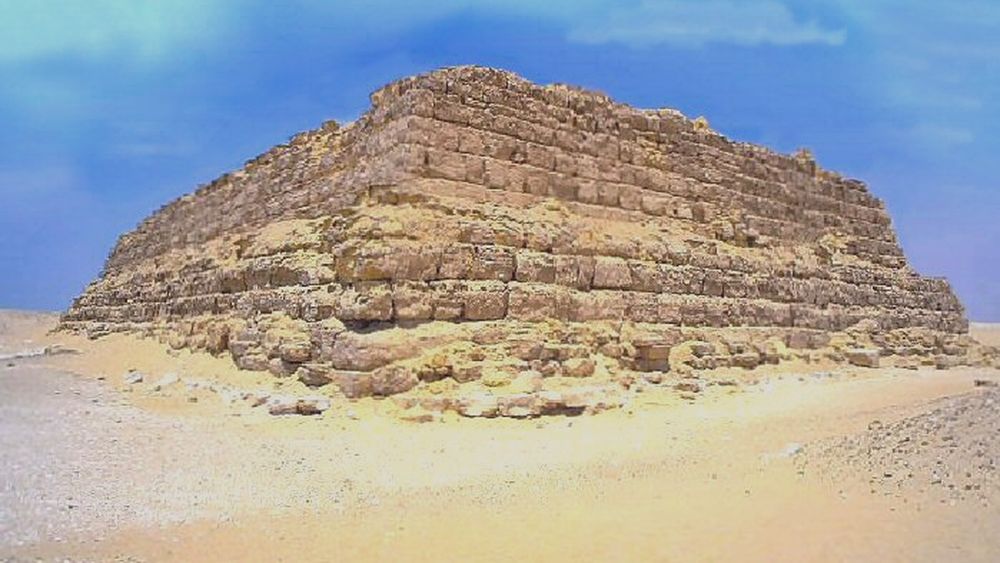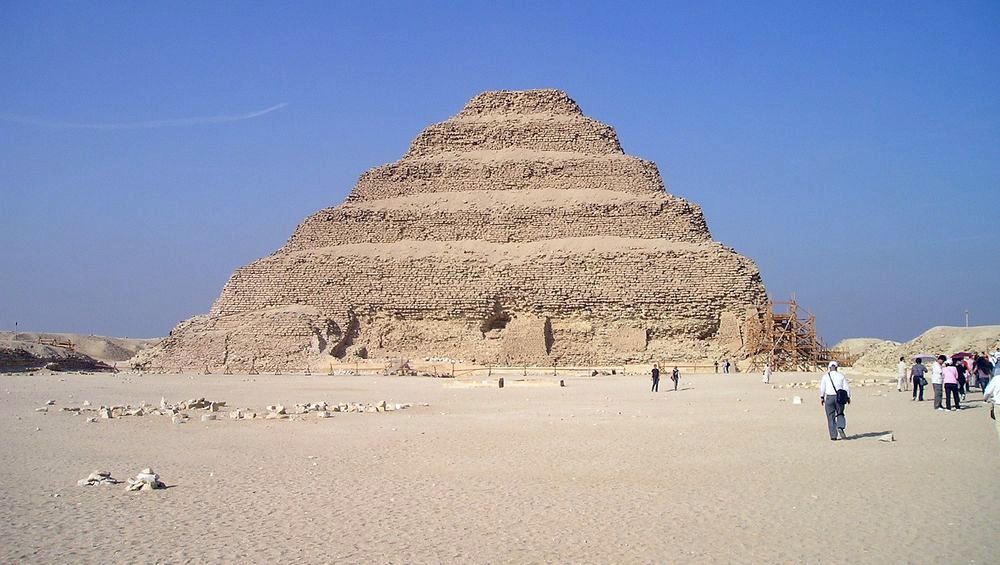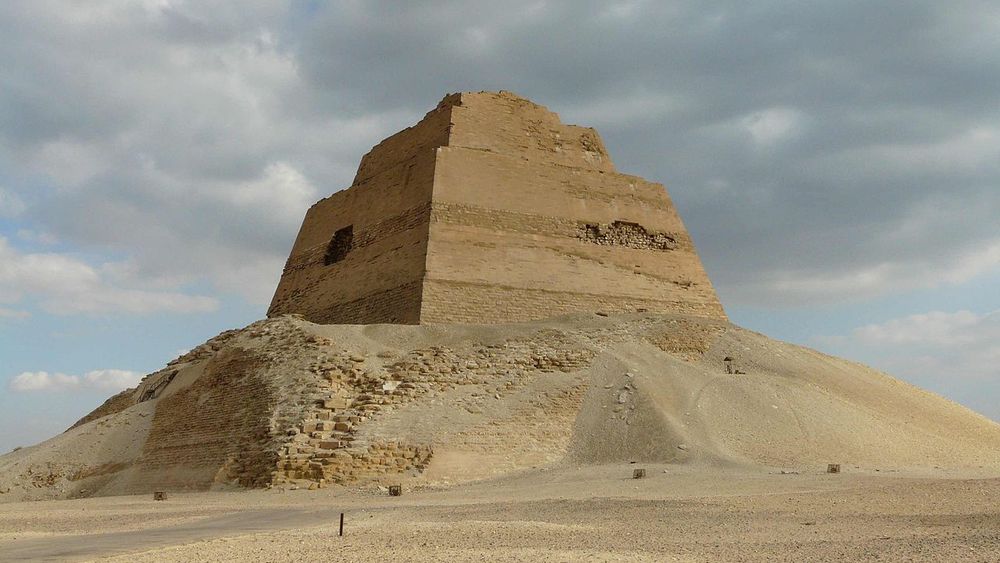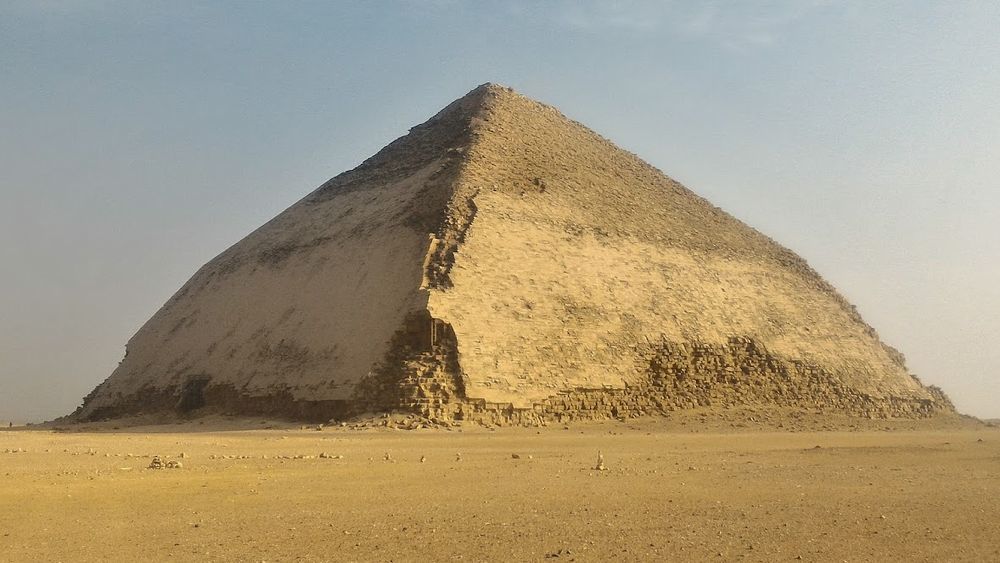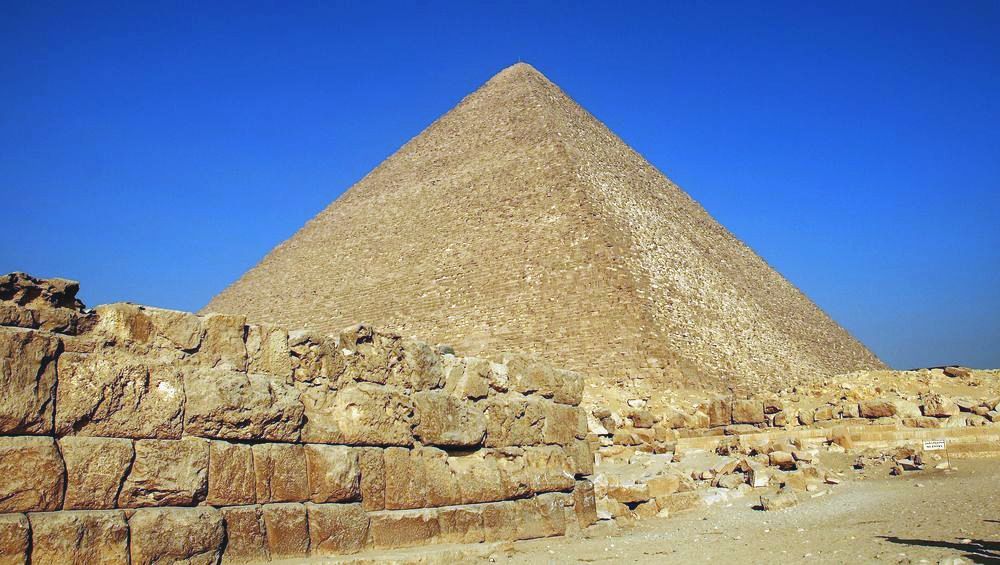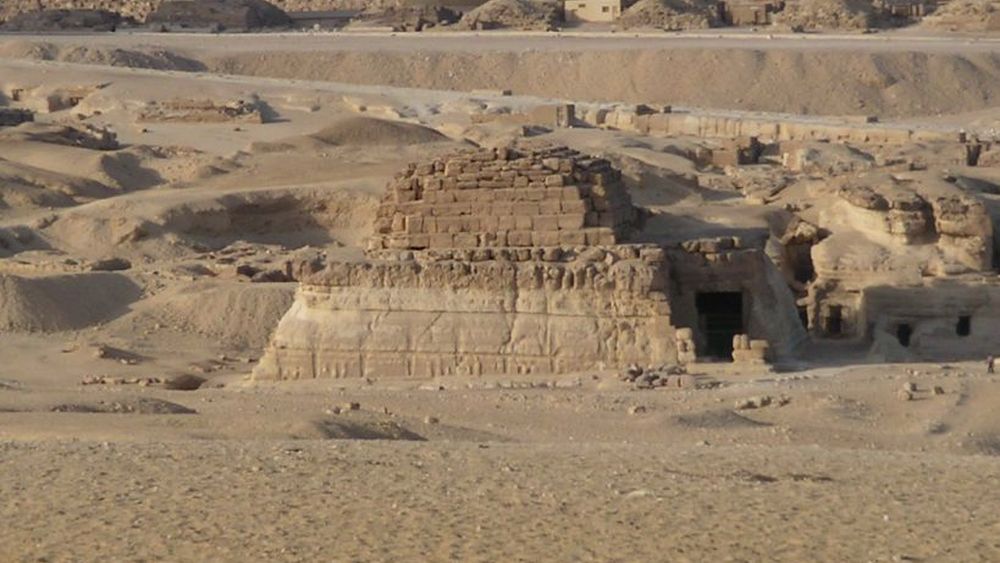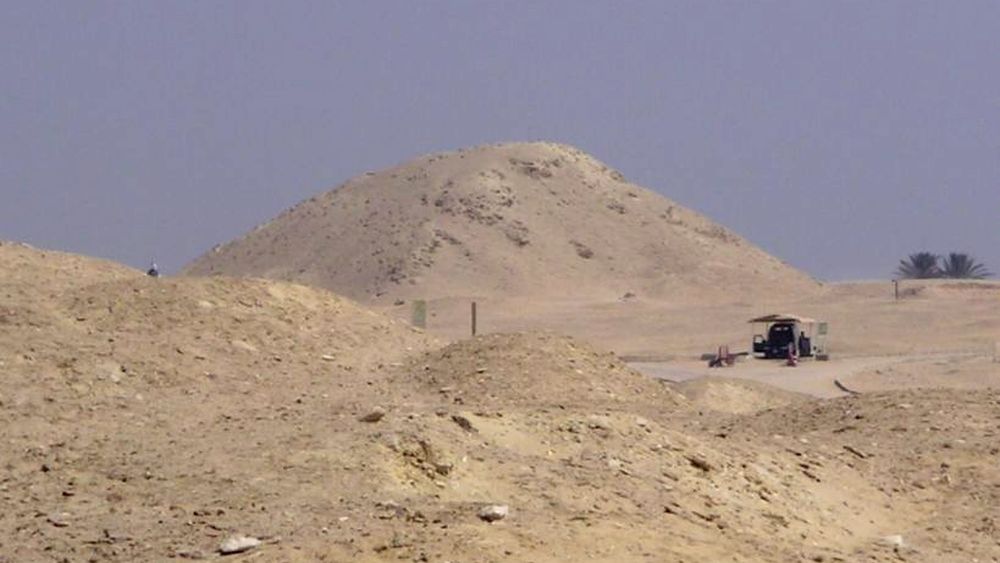"From the top of these pyramids, forty centuries are contemplating you," said the Emperor Napoleon during the Egyptian campaign. If they were mistaken for only a few centuries, it must be said that it is surprising that one of the earliest civilizations that humanity has known was able to build stone pyramids nearly 150m high, without 'they do not collapse on themselves ... while creating many galleries and underground rooms.
Here is the story of these pyramids. It is inserted in the history of Egypt between the beginning of the Old Kingdom and the end of the second intermediate period, with an apogee during the old empire. The period of the pyramids is essentially the old empire.
Before the pyramids: the mastabas (-6000 to -2630)
The Egyptian antiquity begins at the end of the Neolithic period, but obviously this delimitation in time is not very precise, both by the fact that it was a slow evolution and by the lack of material archaeological available. However, when we found this archaeological material, it is often burials that are involved.
The first Egyptian burials date from -6000 years ago, at the end of the pre-dynastic period. It was only alignments of stones marking the body of a person. between -6000 and -3400 there was a period called "predynastic", separated into old and new predynastic. The organization of this civilization made them bury their leaders in rather advanced tombs. These were large pits whose walls were supported by brick walls, the pit being itself divided into several rooms by other brick walls. Thus the living could provide for their deceased king an individual burial chamber and annexed rooms containing the furniture supposed to not accompany.
From -3400 to -2630 there were two historic periods leading to the construction of the first pyramid, Djoser. There was the Protohistoric period and the Thinite period, during which Egyptian society was organized. It counts the first two known dynasties. It was during these two periods that the mastabas were built.
A mastaba is an evolution of ancient pits. It is a building of rectangular plan, whose walls rise with a slope towards the interior of the building. They are made of brick or stone and have, inside, a large network of rooms, antechambers and various shops that make a complete funeral complex. The mastabas have sometimes very deep wells leading to the real burial chamber, always protected by a grid. With mastabas also appears the funerary enclosure, which is only a high wall surrounding the tomb but has an obvious protective role. Such enclosures are built around all the pyramids, but they have unfortunately all disappeared today.
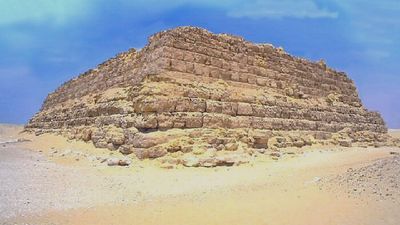
Mastaba of Shepseskaf
The shape of the mastabas is not trivial: It symbolizes the primordial hillock, a rising earth emerging from the ocean of God Noun from which was born the Sun, future God Râ.
The oldest mastabas date from the 1st Dynasty, but they were used until the middle-empire, although rarely. They were mainly built during the 1st and 2nd Dynasties, mainly in Abydos and Saqqara. Some mastabas, even more complex, are formed of two superimposed buildings, they are two-stage mastabas. This is the idea of the step pyramids that will follow.
The first step pyramids (-2630 to -2560)
When Pharaoh Djoser took power on the throne of ancient Egypt, he founded the Third Dynasty, and without knowing it, the old empire. It was then in -2630 and this empire will go until -2200, current on 4 dynasties (IIIe, IVe, Ve and VIe)
The political and economic context
Djoser began his reign by moving his capital from This to Memphis and launched military expeditions targeting sometimes remote mining resources: Nubia, Libya, Asia, Sinai too. He fortified the borders by placing garrisons on the spot and began exploiting the resources of newly conquered territories.
Egypt was then rich and prosperous. The king was strong, undisputed. To govern he relied on nomarchs, sorts of provincial governors who were called "nomes". The royal administration was solid and thus contributed to the improvement of the living conditions of the population. The lands were cultivated, unified linguistically and religiously.
The first pyramid of Egypt
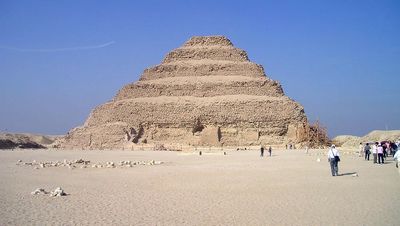
The Step Pyramid of Djoser
The first pyramid is Djoser, at the beginning of the Third Dynasty and the Old Kingdom. She is in Saqqara, following the transfer of the royal necropolis of Abydos to this site. This pharaoh enjoys a period of prosperity due to recent military conquests that have dominated territories on which were interesting quarries, be it precious stones, metals or limestone. With a properly nourished population and advanced techniques for the time, the Pharaoh was able to build his tomb as his predecessors did, but an original event took place. The pharaoh had his mastaba modified, on the proposal of his architect, a certain Imhotep.
Imhotep was a doctor, architect and counselor to Pharaoh. It was he who organized the construction and made sure that the mastaba was correctly realized, but once that was the case, he had it enlarged for the first time, then a second with the addition, in addition, of new galleries underground. Then he had a pyramid built above it, a pyramid that will be enlarged once more to arrive at the final result: A magnificent step pyramid that is still in place nowadays, although a little degraded.
The following pyramids
The pharaohs who succeeded Djoser also tried to build pyramids to degrees, but it was not necessarily successful each time. His direct successor, Sekhemkhet, never completed his pyramid and for good reason: He died before it was over. It must have been 7 degrees and reach 70m high. The pyramid of Khaba is called "slices", it must have been between 5 and 7 degrees, but it too was not completed. There is in Saqqara the remains of a pyramid so degraded that the French Egyptologist Jean-Philippe Lauer, specialist Saqqara, thought it was a mastaba. It is called the Lepsius Pyramid No. 1, named after the German Egyptologist who cataloged the pyramidal buildings of Egypt. It was in raw bricks, with degrees, but it had a siding that gave it the appearance of a pyramid face smooth. Nowadays it is only a big pile of stones of 20m of height, alas.
Provincial pyramids
Provincial Pyramids are called the 8 small step pyramids that were built by Houni, the last pharaoh of the Third Dynasty or Snefru, the first of the Fourth Dynasty. These are pyramids of modest size, between 10 and 17m, which have the distinction of having been built in the province, in the nomes. They are found at Edfu, Elephantine, Abydos, Nagada, Al-Kula, Sinki, Zawiet-el-Meitin, Seilah and Athribis.
Learn more about the step pyramids
Learn more about provincial pyramids
Missed attempts at smooth-faced pyramids (-2575 to -2551)
Now at the head of a strong and perfectly unified empire, with a vast territory including Sinai, rich in rare minerals, and Nubia, with interesting granite quarries, the Pharaoh could assert his authority over a powerful administration and firm, loyal to him. It had dedicated senior officials who relayed orders to the provinces to maintain control over the population while monitoring trade. The army ensured peace inside and outside the country, triggering a welcome period of pomp.
We found traces of the economic activity of the beginning of the IVth Dynasty. For example, there was an expedition of 40 ships to Lebanon to recover cedars used for making ships or doors. Militarily, Snefrou triggered two conquests: one in Nubia, the other in Libya. These conquests made it possible to recover many slaves whom they made work in the quarries, but also cattle to feed the population.
Thus it was possible to initiate "pharaonic" projects, ie of such a magnitude that only the pharaoh could trigger them. And beyond the simple stroke of a Pharaoh, it was the entire Fourth Dynasty that was able to build a large funerary complex, proving that the empire was rich enough to afford a succession of grandiose buildings without making to suffer the people beyond measure. It is interesting to note that at another time, in a completely different place of the planet (XVIIe century, in India), a king made build a building of a complexity similar to the pyramids of Egypt: The Taj Mahal. But where the Egyptians reiterated the feat to each pharaoh, the Mughal chiefs of India could not do it, the finances of the kingdom having been emptied for the occasion.
Attempts to improve
It is Pharaoh Snefrou, creator of the IVth Dynasty (-2575 to -2551), who tried to make the first pyramids with a smooth face. However, he had to miss two before he could succeed. The results of these errors are still visible nowadays, and one of them is also one of the best preserved pyramids of today: The rhomboidal pyramid. The other, made just before, was the Meidum pyramid. But after these two failures he managed to achieve one: the red pyramid, which is not only the very first smooth-faced pyramid in Egyptian history, but also the third in volume still in existence today (after those of Khufu and from Khafra)
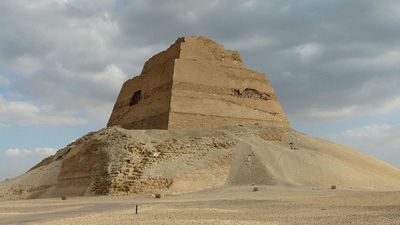
The Step Pyramid of Snefrou, Meidum
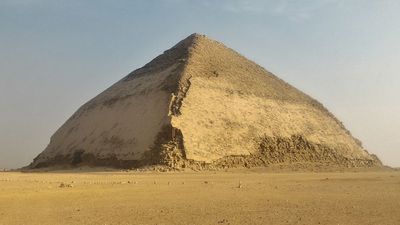
The rhomboidal pyramid of Snefrou
Learn more about Smooth faces pyramids attempts
The era of the giant (-2551 to -2494)
From there, the successors of Snefrou built pyramids larger and larger, higher and higher, it is the beginning of the era of giant, a rather short period.
It begins with Snefru and its red pyramid, continues with the son of Snefrou, Khufu, also called Khoufou, and ends with the grandson of Khufu, Khafra. Three pharaohs, three monumental pyramids. They correspond to the highlighting of previously acquired techniques, and pushed to their paroxysms. More than 150m high, 5 million tons, 2.5 million limestone blocks: This is the result of the pyramid of Khufu, in figures. But this gigantic realization masks a misunderstanding of who this pharaoh was, as well as his father Snefrou and his son Khafra.
We know, however, that Egypt at that time was prosperous, that raw materials were plentiful, thanks in particular to the mines of Sinai and Nubia, and that the administration was loyal and efficient. The word of the Pharaoh was applied, obviously without worries, in the different nomes (governorates) of the kingdom.
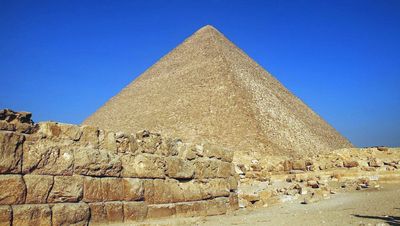
The pyramid of Khufu
It should be noted that during the era of the giants, there was the reign of Djedefrê, son of Khufu and brother of Khafra. He built his pyramid in the necropolis of Abu Rawash. It was a pyramid 68m high for a base of 105m side, but unfortunately it was used as a stone quarry in Roman times, and suddenly, there is almost nothing on site.
Learn more about giants pyramids (IVth dynasty)
The golden age of the pyramids (-2494 to -2330)
The golden age of the pyramids is of course the pinnacle of this tradition. It corresponds to a certain normalization of the royal funerary architecture which is characterized by smaller pyramids (78.6m side, or 150 cubits, and 52.4m side, or 100 cubits), ancillary buildings of the same type and underground galleries of great complexity.
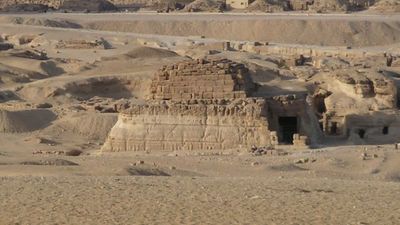
Pyramid of Khentkaous
This period corresponds to the 5th Dynasty, which begins with the pharaoh Userkaf. Apart from its funerary complex, Userkaf introduced into the religious ritual the worship of the Sun within a new type of building, the solar temple. Each ruler who succeeds him will have his pyramid and a solar temple built, usually in different places. These temples have unfortunately disappeared nowadays. Usutorkaf's successor was Sahouré, of whom we know very little of the reign, then came Neferirkare, whose pyramid at Abusir was the seat of a large-scale discovery: The Abousir Archives. It is a set of texts on papyrus describing the functioning of the society of the old empire, with accounting documents, royal decrees, rules governing worship, etc. Neferirkare having died young, it was his wife Khentaous II who assured the regency the time that his two sons were old enough to govern. (The two will rule Egypt, one after the other) Their successor is the pharaoh Niouserrê, whose activity of builders was productive: Apart from his own tomb, he made finish that of his mother and that of his brother.
The following pharaoh built his funeral complex at Saqqara, unlike his predecessors. This is Djedkarê-Isesi. His pyramid is the last one to be placed in the golden age, since a novelty will appear with his successor Ounas, and this novelty is important enough to justify a change of era.
Learn more about the golden age of the pyramids.
The pyramids with texts (-2330 to -2200)
Introduced by Pharaoh Ounas, the last of the 5th dynasty, the text pyramids are characterized by the abundance of texts written inside the galleries. Before, no inscription was made on the pyramids, neither inside nor outside. From the Ounas, the galleries are covered with hieroglyphics, and this is a state of affairs that will continue throughout the 6th Dynasty.
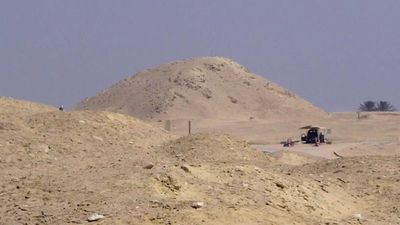
Pyramid with texts of Teti
The reason for this change is simple: The gradual loss of power of the pharaoh. After a fourth and fifth strong dynasty, the sixth begins the decline of centralized power in favor of the nomarchs, the provincial governors. The latter allowed themselves, little by little, to "nibble" the power of the pharaoh who brought the end of the old empire to the benefit of the first intermediate period, a period without central power.
The relationship between the loss of central power and the hieroglyphic writings lies in the fact that these texts explain how the soul of the Pharaoh, the famous Kâ, joins the primordial ocean through the story of the different stages to be crossed. But this knowledge was unique to the Pharaoh, the only divine person on Earth and therefore the only one to know how to get there. In writing these explanations on the walls, the Pharaoh gives some of his knowledge to the whole people (at least symbolically, since nobody had the opportunity to visit the galleries, once the pyramid closed). The text pyramids are therefore proofs of the pharaoh's power loss.
On the rising pavement of the pyramid of Ounas one finds sets recalling the facts of his reign. We learn that there was at that time a famine. His successor, Téti I, founded the 6th Dynasty. This dynasty was, at first, still prosperous and solid because it relied on loyal officials, but gradually trust fell. The nomarchs began to be no longer appointed by the Pharaoh but, this charge becoming hereditary. As a result new provincial dynasties appeared. The successor of Téti I was the brief Ouserkare, followed by Pepi I, whose reign was marked by the beginning of the decline of the old empire. It was indeed under Pepi I that alliances were formed between the nomarchs to avoid the influence of the royal power, alliances that led to the isolation of the pharaoh. After Pepi I, there were the reigns of Merenre I and especially Pepi II, a very long reign which allowed the nomarchs to win against a governor weakened by age and whose children, normally educated to exercise power from a very young age, take the reins of the kingdom relatively quickly. In the case of Pepi II, his reign was so long that not only did he no longer have the strength to maintain his kingdom in one block under his authority, but at his death his children were too old to be able to do so too. Without great energetic decision, without firm will, the kingdom broke up little by little, whole sectors of the economy being abandoned in favor of the nomarchs who divided the kingdom.
Thus ends the glorious period of the pyramids of Egypt. But not quite, since jolts of history will still appear some during the twelfth and thirteenth dynasties, and until the end of the second interim period.
Learn more about pyramids with texts (5th Dynasty)
The rebound of history in the twelfth dynasty
Throughout the first intermediate period the pharaohs lost the habit of being buried in pyramid complexes. The Middle Kingdom completely abandoned this tradition with the exception of the Twelfth Dynasty which returned there. It must be said that with the revival of the central power, starting point of the middle-empire, the activity of the pharaoh has changed a little. First of all, he forbids the inheritance of the charge of nomes, preserving only one dynasty, his own. Then he closely supervises his administration, and especially his senior officials. The clergy is also under surveillance. Militarily Pharaoh created a professional army, which did not exist until now.
Then the very role of the pharaoh changes. He is no longer that mysterious being, of divine origin, but a head of state, an accessible leader. Besides, he spends more time on the construction of his tomb, which was once his main concern. From now on the tombs are simple. From the twelfth dynasty they become huge funerary complexes, but curiously there is not one left to testify because all the pyramids were destroyed by the time or the action of the man who used these pyramids as careers. Why specifically they and not those of the old empire? This is because they were not made of heavy blocks of limestone, difficult to transport, but in brick. Less expensive, easier to assemble, the brick pyramids were also easy to dismantle, which explains their disappearance nowadays compared to those of the plateau of Giza.
Learn more about the pyramids of the middle empire (XIIth and XIIIth dynasties)
The last pyramids (-1785 to -1552)
The last pyramids were built during the thirteenth and seventeenth dynasties, that is to say at the end of the second intermediate period and the beginning of the New Kingdom. We are between -1785 and -1552. It was essentially for the pharaohs of these times to place themselves in the footsteps of their predecessors. The last to build a pyramid was Ahmose I, who was the first pharaoh of the eighteenth dynasty at the beginning of the New Kingdom.
Learn more about the late pyramids (XVIIth and XVIIIth dynasties)
See also:
All the differents kinds of pyramids






